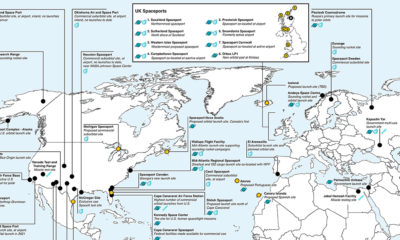
Written By Tessa Di Grandi
Article & Editing
- Katie Jones
Published October 24, 2022
•
Updated October 24, 2022
•
TweetShareShareRedditEmail
The following content is sponsored by KGP Auto
Can Electric Vehicle Targets Be Met?
By 2040, just 38% of the automotive market will be made up of battery electric vehicles (BEVs). The problem is, this number needs to hit at least 65% in order to reach net-zero targets.The above infographic sponsored by KGP Auto explores this theory further, and breaks down some of the key reasons why the EV market needs to urgently shift gears in order to make mass adoption a reality. First, let’s take a bird’s eye view of the market for context.
The EV Market So Far
In 2021, global electric vehicle sales doubled—however some regions contributed a lot more than others.
China, Europe, and the U.S. made up nearly two-thirds of the EV market and 95% of total electric car sales in 2021. In fact, China sold more electric cars in 2021 than the rest of the world combined in 2020.
Global forecasts for EV rollouts vary, with countries around the world pledging targets for 2035 and 2040. At The UN Climate Change Conference (COP26), more than 100 stakeholders signed a declaration to speed up the transition to 100% zero emission cars and vans by 2035-2040.
Why Is It Unlikely We Will Meet Targets?
Even as pledges vow to increase the forecast share of EV adoption, we still need to consider headwinds that will slow down the EV rollout.
Roadblock 1: Resource Constraints
Sourcing critical raw materials will be the most significant challenge for the rollout of EVs, as demand outstrips supply. Although some areas of the EV production line can be fast-tracked, mineral extraction times cannot, which will cause major setbacks to EV production. In fact, it can take anywhere from 4-20 years for a mine to begin commercial production. In addition to the time taken to achieve commercial production levels, a mine can take up to another 10 years before reaching nameplate production capacity.
Roadblock 2: Cost
Although EVs are becoming more affordable, purchase price remains high in emerging markets, limiting mass adoption.
Many countries have been slower to incorporate EVs into their automotive fleets, with India, Brazil, and Indonesia making up less than 0.5% of global electric vehicle sales in 2021.
A continued increase in the cost of raw materials as well as global interest rate rises may also contribute to limited affordability and slow mass adoption.
Roadblock 3: Infrastructure
The growing construction of charging infrastructure will also increase demand for raw materials like copper and nickel.
Charging infrastructure also varies across markets, with France, Germany, and the UK currently not meeting EU charger availability recommendations.
Providing enough charging infrastructure will be especially difficult in emerging markets.
Another Road to Decarbonization
While the rollout of EVs is underway, the momentum needed to reach net-zero targets will be slowed by resource constraints, cost, and infrastructure. It’s therefore essential we consider all paths to decarbonizing the auto industry.
Alternative solutions such as a fuel-mix strategy laid out in KGP Auto’s new report could sustain momentum to net-zero targets, with internal combustion engines (ICEs) continuing to make up the majority of market share for the next few decades.
In this strategy, ICEs, plug-in hybrid vehicles (PHEVs), and fuel cell electric vehicles (FCEVs) with alternate fuels such as hydrogen would bridge the gap to net-zero targets as raw-material supply, infrastructure, and affordability improve to support BEVs.>> Read KGP Auto’s Powertrain Outlook Report to learn more.

Please enable JavaScript in your browser to complete this form.Subscribe to our free newsletter and get your mind blown on a daily basis: *Sign up
Related Topics: #infrastructure #manufacturing #electric vehicles #raw materials #supply chains #decarbonization #automotive industry #KGP Auto #mineral extraction
Click for Comments
var disqus_shortname = "visualcapitalist.disqus.com";
var disqus_title = "Can Electric Vehicle Targets Be Met?";
var disqus_url = "https://www.visualcapitalist.com/sp/can-electric-vehicle-targets-be-met/";
var disqus_identifier = "visualcapitalist.disqus.com-152975";
You may also like
-

Agriculture1 day ago
How Big is the U.S. Cheese Stockpile?
The U.S. has 1.5 billion pounds of cheese in cold storage across the country—around $3.4 billion worth of cheese.
-

Mining4 days ago
All the Metals We Mined in 2021: Visualized
See all the 2.8 billion tonnes of metals mined in 2021.
-

Datastream4 days ago
UK Prime Ministers with the Shortest Term Length
As Liz Truss becomes the shortest-serving prime minister in UK history, we look at other whirlwind tours of Number 10 Downing Street.
-

Markets5 days ago
These Global Cities Show the Highest Real Estate Bubble Risk
A global look at which cities have the most overheated real estate markets. Toronto shows the highest bubble risk in 2022.
-

Technology6 days ago
All of the World’s Spaceports on One Map
This map is a comprehensive look at both existing and proposed spaceports and missile launching locations around the world.
-

Culture1 week ago
20 Years of Top Trending Google Searches
What major stories have captured the world’s attention over the years? This graphic highlights the top trending Google searches since 2001.
Subscribe
Please enable JavaScript in your browser to complete this form.Join the 350,000+ subscribers who receive our daily email *Sign Up
The post Can Electric Vehicle Targets Be Met? appeared first on Visual Capitalist.